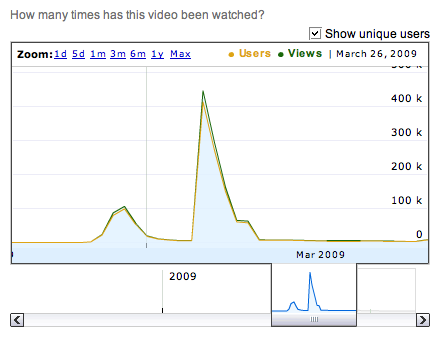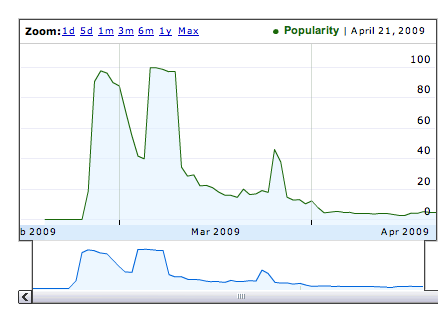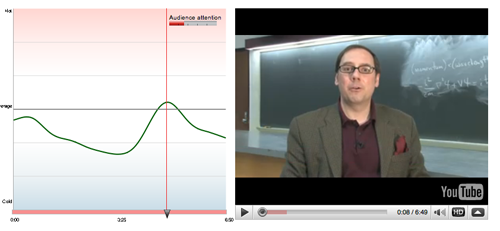I stumbled upon this YouTube blockbuster, the Science of Watchmen, just 2 days ago as I was browsing YouTube EDU.
It’s not the most viewed university video of all time (Randy Pausch’s Last Lecture from Carnegie Mellon is with more than 9.5 million views), but this YouTube video produced by the University of Minnesota has really achieved a big success in terms of viewership with more than 1.5 million views since it was posted on February 24, 2009 – just 2 months ago today.
After a quick look at the YouTube channel of the University of Minnesota, I noticed that it included several successful videos (with views in the ten of thousands range for several of them). That’s what pushed me to try to learn a bit more and to ask a few questions to the person in charge of this channel: Elizabeth Giorgi from the News Service at UMN Office of University Relations.
Here’s the transcript of this interview – it’s long but definitely worth your time if you’d like to learn more on smart tactics to go viral on YouTube with educational videos.
KJ: I was really impressed by the number of views this video got in under 2 months. Did you keep track of the progression? Would you be willing to share some of the stats available in YouTube Insights about this video?
Elizabeth Giorgi: In a lot of ways, this video was a test run for us for moving in an unconventional direction with our video content. We watched the video very closely, because we wanted to gauge whether or not a higher education institution could truly produce a viral video with an educational twist and actually get watched. Sure enough, it built a lot of steam that week leading up to the movie, but the Watchmen opening weekend was a game changer. I have attached a few images from our Insights to show you the incredible increase in viewer ship starting at the weekend when the movie opened. For instance, on March 6th, we had nearly 500,000 views that day.

One huge part of our success was working with YouTube directly to promote the video. I let one of our contacts there know about the video and asked him if he thought we could get it featured on the Science and Technology page. After viewing it, the editor of that section thought it was a great video and as a result, 23% of our views came from that promotional spot. Once it built steam however, the featured video on the home page of YouTube happened on its own, and is responsible for 59% of the hits. That week, we peaked as one of the most watched channels, I believe the 23rd, and were getting inundated with requests to speak with Professor Kakalios to ask him more questions about his work.

In addition, Warner Bros found out about the video and contacted us to let us know that they would be sending out a press release about the video to their contacts as well. A huge part of this effort was building those partnerships, and we feel it has been a successful effort.
KJ: At 6 minutes, it’s rather long for YouTube and I’d be curious to find out if people are watching the full video or dropping at some point. With some many views, there’s very interesting and relevant data there.
EG: The data here shows that viewership interest peaks at right around the 5 minute mark, which gave us the impression that people thought the video length was appropriate. The blend of video clips between Watchmen footage and the experiments definitely helped to keep viewers interested. There is also an attached image for this that shows the peak.

When we started brainstorming this idea, we realized early on that in order to get through all these topics, we needed to get footage from the movie. We normally would not approach the 5/6 minute mark, but the quality of the topic and the fact that Professor Kakalios is so well-versed and connected to the subject gave us the impression that it might be worth breaking our own rules.
KJ: How did you promote the video (and your channel)? Did it became viral after something special you did? Was it featured for a long period of time on YouTube homepage?
EG: We strategically timed the release of the video to come out around the time that the initial Watchmen movie reviews would be in the media and on blogs. This was in the hopes that we could get reporters and bloggers to embed our video in that initial week. This was a fairly successful tactic, as about 4.8% of that viewership came from embedded players. The idea was that as we were pitching Professor Kakalios to the media, we would also send the video their way to give them: 1. An idea of how well versed he is on the topic, and 2. Provide them the opportunity to include the video on their story or post. The result? 396 individual hits on blogs, tv and news papers between coverage of the video, Professor Kakalios and mentions of the video and Professor Kakalios in stories about Watchmen.
We also did a lot of research about bloggers that had written about Watchmen in the past. We knew there was a cult following out there, but we weren’t sure how to tap into it. A critical part of this was getting the video posted on a Gawker site. After it had reached the front page of YouTube, it was there for about 3 days, which far exceeded our expectations.
KJ: I’ve had a look at your other videos and you got quite a few successful ones. Have you defined special features a video needs to have to get great viewership on YouTube?
EG: This video has helped us figure out new ways to approach our content. We have adopted a strategy that we call REE. That stands for Research, Educate and Entertain. We believe that if you can make research accessible by teaching people about interesting concepts while entertaining them, you will have them hooked. Also, it is important that we maintain that educational component because of how our faculty members view these things. Professor Kakalios even told us, “I could teach 500 students per semester for over a century before I would reach this many people.†For them, teaching is a priority and we want to make sure we are highlighting their incredible talent.




Thanks, Karine! Very valuable. Some key points for me:
–They leverage high-tech research with pop culture
–The promotion is multi-pronged–both campus and partnership-based–and drives an initial set of viewers who take the video viral
–All the video metadata is correct and there is a YouTube HD option (see the video on its YouTube page at http://www.youtube.com/watch?v=zmj1rpzDRZ0 )
–They use analytics data that gives them the ability to determine not just hits, but other key bits of information such viewer origin and how long viewers remained engaged.
–It fits into an overall viral video strategy
Interestingly, I found it impossible to find this video from the university’s home page.
We have seen through Haagen-Dazs’ support of UC Davis’ honeybee research how powerful promotional partnerships can be. There is a video component (see http://www.youtube.com/watch?v=BOIP0UPiLvA for one example), along with a Web site, campus promotion, honeybee garden design contest, product packaging promotion and other PR efforts. The end result is that the honeybee fund is one of the best supported funds on our giving site, and UC Davis benefits from increased, positive public exposure.
This is all very interesting.
We who are fundraisers would like to know whether there is any credible data that has been gathered from this or similar activities that tell us how many hits or views turn in to some kind of support for the University. Is there any data that shows the return on the investment in production, etc.?
Thank you.
Somewhat as an aside to the main thrust of the conversation above but still science related anyway (and in answer to Les above). The University of Nottingham here in the UK developed some mini science videos which were posted to you tube and caused huge interest.
It has increased traffic considerably to Nottinghams site but you tube also approached the university to ask if it could place advertising banners across its vdeos as they were so popular and in turn they paid the university a substantial sum for the pleasure.
One direct example on return on investment of production in the first place.
Links: http://www.periodicvideos.com/
Tristan…I love it! I can imagine how many high schoolers end up watching those videos. Amazing project to put together.
Excellent video! How can you go wrong with super heroes and physics? I wrote a post about the Randy Pausch video a while back. I’m sure that’s the most viewed because not only is it a wonderful lecture by an amazing man, it’s also got “poignant” and “heartbreaking” written all over it. It’s hard for other YouTubers to compete with a well-loved, soon-to-be-gone professor giving his last lecture.
–Alexa
[…] has been working on this formula for some time and with some noticeable successes including an online video with more than 1.5 million views in less than 2 months. She will explain what she has learned in the webinar she is scheduled to present on September 17, […]